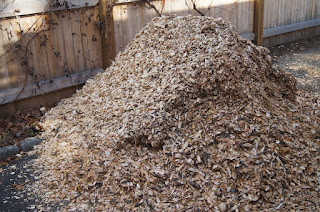Three years ago they brought a whole dump truck’s load, and it made a pile almost too huge for me to deal with.
I got the idea of using wood chips as mulch from reading Linda Chalker-Scott, known to her admirers as “the Mulch Queen.” She is a professor of urban horticulture at the University of Washington at Puyallup and a myth-buster who applies scientific principles to conventional wisdom in gardening. She and colleagues blog at The Garden Professors, which is a great source of unembroidered horticultural truths.
Chalker-Scott has reviewed the scientific literature on mulch and conducted her own experiments. She recommends arborist wood chips as the best mulch of all.
Before trying the wood chips, I was happy with the mulch I made from fall leaves. I never have enough for the whole yard, though, and the leaf mulch decomposes fast, mostly melting into the soil within a year.
I was still supplementing this homemade product with bark mulch I bought at garden centers or Home Depot.
The wood chips are superior in several ways. First, they’re free. Kevin is willing to give them to me; otherwise he’d pay to dispose of them. Second, they do impressive work building soil. I was amazed when I first dug through a layer of wood chips to plant some native Allegheny spurge (Pachysandra procumbens) in a shady area under a line of trees. The soil under the mulch was rich, black, moist, and easy to work. When I’ve dug under bark mulch, I’ve sometimes found the soil dry and hard, possibly because the wax in the bark can prevent water from penetrating the mulch layer.
Another good feature of the wood chips is that they’re easy to handle. A wheelbarrow full of chips is much lighter than an equivalent volume of bark mulch, which is so dense that I can barely heft a bag from my car to the wheelbarrow.
The look of the chips is an acquired taste. I found their blonde color jarring when I first laid them down. Now I’ve gotten used to it, and I know that over a few months they’ll fade to a less conspicuous gray and later to brown.
 |
| A path of aged wood chips |
So I’m spending this weekend shuttling back and forth with my wheelbarrow, adding a new layer of wood chips to my garden paths. The next priority will be the berm at the back of the yard, where they’ve been enabling water to soak down to the roots of mature evergreens that screen us from our neighbors (The only place not to use the chips is around vegetables and annual flowers).
It almost feels like the gardening season has started!



No comments:
Post a Comment